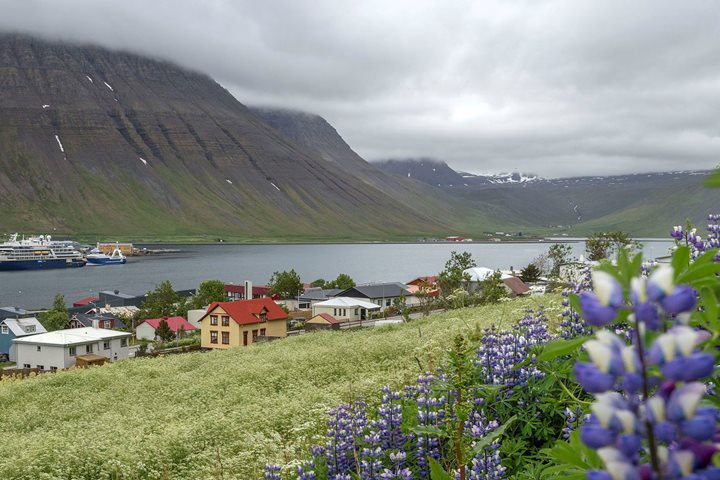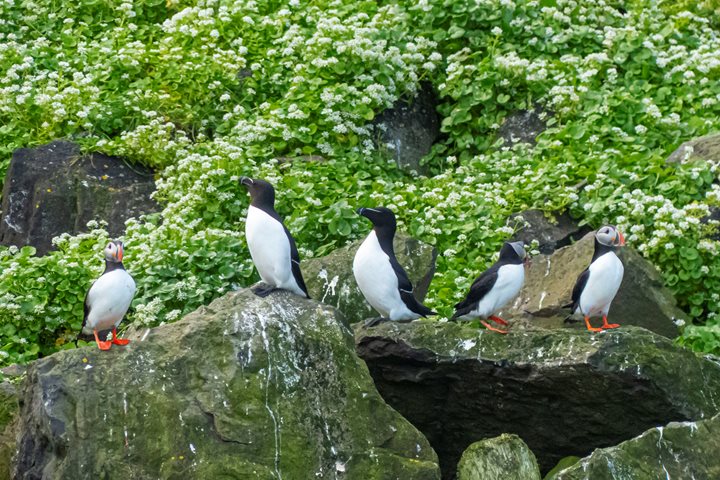Our luck held with another beautiful day of perfect weather. And, we found a wonderful region in which to enjoy it all. Our ship reached Grimsey late last night and anchored just off the protected little harbor, giving us a quiet night to prepare for our first landing in Iceland. Right after breakfast, we went ashore and spent a few hours walking around this green and lush island with a population of about 300 people. This is an ancient fishing community with a long history of living off the sea. Fulmars and basking sharks sustained the islanders for countless generations, but in modern times (with modern fishing boats), it is the codfish that have taken over. For us, it was an excellent place to stretch our legs and enjoy the bountiful birdlife. In addition to kittiwakes and fulmars nesting on the low cliff faces, many of us encountered our first close-up puffins. There were hundreds, no thousands, of puffins rafting offshore and many others standing in front of their burrows along the upper edge of the grass-covered coastal slopes (Figure A). There’s no denying they are incredibly appealing. The inland areas were fairly swarming with arctic terns that were nesting in the fields of tall grass.
An interesting aspect to this island is that it lies right on the Arctic Circle. So, yes, Iceland does reach north of the Arctic Circle. Visiting a monument commemorating the circle was not particularly exciting to us, because we had spent the entire voyage NORTH of the Arctic Circle until this moment. For those who don’t know, the Arctic Circle is an imaginary latitudinal line that encircles the globe, and is defined by a very real natural phenomenon. The Earth is tilted on its rotational axis by precisely 23.44° (23° 26' 24") relative to the vertical plane of its horizontal orbit around the sun. On the day of the Summer Solstice (which is usually June 21st), the North Rotational Pole faces its most direct angled position towards the sun. Therefore, a person located anywhere less than 23.44° from the North Pole during that day would be able to see the sun continuously for 24 hours…as the Earth makes one complete rotation. The latitudinal position that corresponds to 23.44° from the North Rotational Pole is precisely 66.56° N, which is also written as 66° 33' 36" N. This latitudinal position, which forms a line circling the globe, is called the Arctic Circle. The same phenomenon holds true for the southern hemisphere, but occurs exactly six months later during the Austral Summer. Therefore, the Arctic and Antarctic Circles demarcate the polar territories that experience at least one complete day of direct sunlight during the summer solstice, and at least one complete day of no direct sunlight during the winter solstice, each year. Of course, the closer one is to the rotational pole during the summer, the more days of total sunlight one enjoys…which is why we experienced many 24 hour-long sunlit days in the high latitudes of Svalbard and the Greenland Sea.
In the early afternoon, we enjoyed a special Fourth of July hamburger barbecue on the aft deck for the Americans onboard, after which we arrived in the quaint and colorful harbor town of Siglufjörđur, on the northern coast of mainland Iceland. It has a long local history, but is important to world history for the fact that it was the major herring fishery base for Iceland beginning just after World War II until the late-1960s. The harvest of herring during much of that period is almost unimaginable. During the herring heydays, which occurred only during the short summers (June through August), the town came alive with hundreds of fishing boats and thousands of fishermen and fish-processing women (known as ‘herring girls’) who worked almost continuously for three frantic months. Then, they lived off their earnings for the rest of the year. The industry abruptly ended in 1969 with the collapse of the herring population, and never came back. After years of decay and neglect (Figure B), much of the fishing materiel has recently been collected and restored by local residents, and put on display in an award-winning complex of several waterfront buildings. Our visit to the Herring Museum complex was astounding, fascinating, and educational. Just by chance, today was also the day of the local Folkloric Music Festival, so we decided to stay late alongside and give people the opportunity to go back ashore after dinner to enjoy more strolling around and perhaps listen to some nice music.







